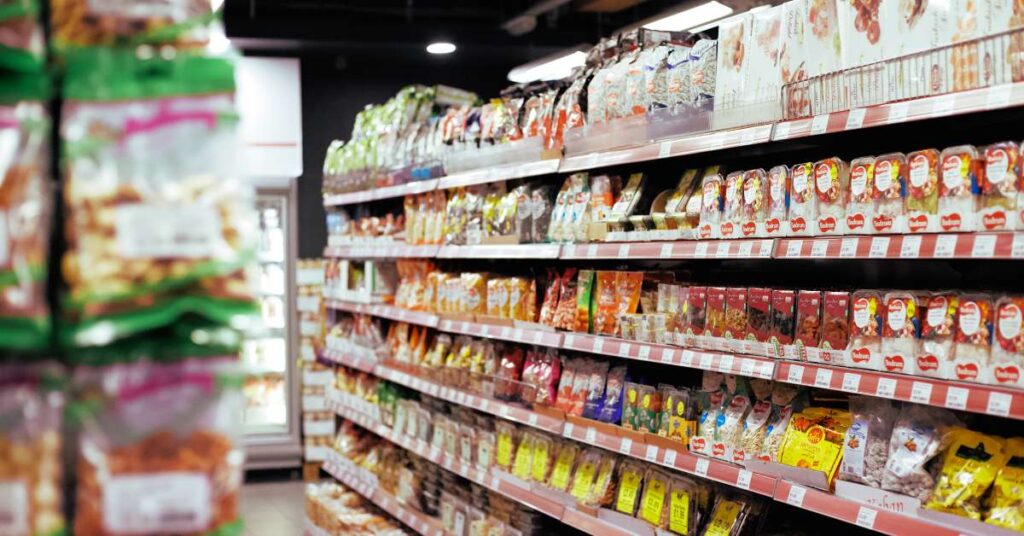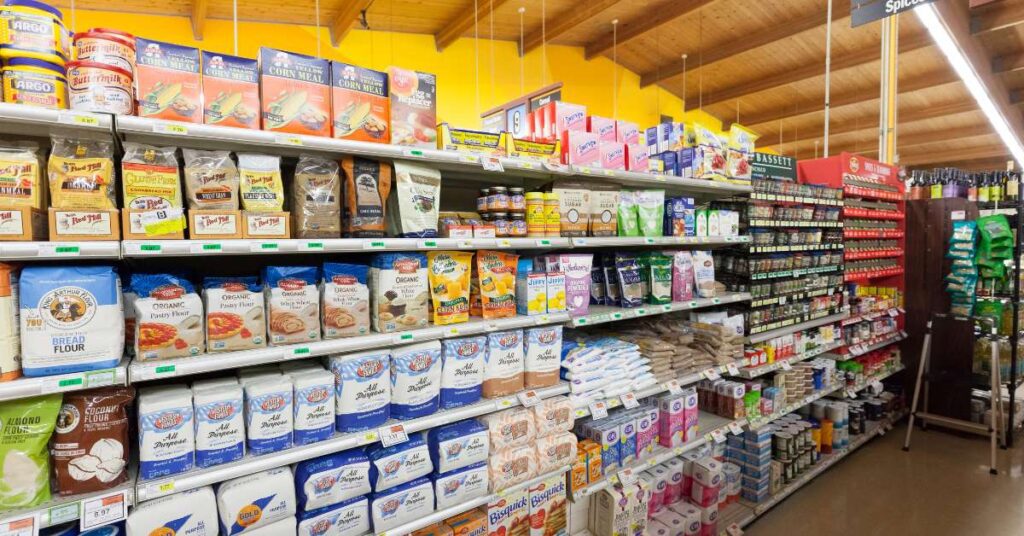In a world full of uncertainties, being prepared for the unexpected is paramount. For preppers, assembling a strategic collection of essential items goes beyond mere precaution – it’s your shield against unexpected twists. Sometimes, all you need to do is put together a survival food list from the grocery store.
Your survival food list from the grocery store should include a variety of non-perishable, shelf-stable essentials such as canned meat, vegetables, fruits, beans, grains, essential beverages, and any special dietary items. Focus on well-rounded nutrition, long shelf life, and dietary preferences.
Below, we’re breaking down the code of non-perishable and freeze-dried foods and unveiling the secrets of smart food storage. But first, let’s learn about the essential things and terms to know before shopping.
Essential Criteria for Shopping Survival Foods

To ensure you’re well-prepared for any situation, consider these key criteria when shopping for survival foods:
Nutritional Value
The foundation of a solid survival food supply lies in its nutritional content. Opt for foods that offer a well-rounded blend of vitamins, minerals, protein, and carbohydrates. Look for options that provide essential nutrients to sustain energy, promote health, and support overall well-being.
Taste and Palatability
Survival foods need not be bland or unappetizing. Prioritize items you and your family enjoy eating, as maintaining morale during challenging times is essential. Choose flavorful options that can boost spirits and provide comfort, turning mealtimes into moments of solace.
Long Shelf Life
In the world of survival foods, longevity is key. Select items with a prolonged shelf life to ensure they remain edible and safe for extended periods. Look for products specifically designed for long-term storage, helping you stay prepared for whatever may come your way.
Minimal Preparation
Opt for foods that require minimal preparation, such as ready-to-eat or easy-to-cook items. This ensures you can quickly access nourishment without complex cooking processes or extensive resources.
Dietary Considerations
Every individual has unique dietary needs. Consider any dietary restrictions, allergies, or sensitivities when choosing survival foods. Prioritize options catering to these considerations, ensuring everyone’s health and well-being are upheld.
Cost
Building a survival food list from the grocery store is an investment in your future security, but it’s essential to consider your budget. Seek out cost-effective options that offer a balance between quality and affordability. Remember that while initial costs may vary, the value of preparedness far outweighs the expense.
Key Terminologies

Here are the definitions for each of the essential terms to know before shopping for survival foods:
Shelf-stable: It refers to food products that can be stored at room temperature without the need for refrigeration or freezing.
Non-perishable foods: Non-perishable foods can be stored for an extended period without spoiling or becoming unsafe to consume. These foods typically have a low moisture content.
Vacuum-sealed: This involves removing air from the packaging before sealing it, which helps to preserve the freshness and quality of the food inside.
Canned foods: These are products that have been preserved by sealing them in airtight containers, typically metal cans.
Frozen foods: These items have been subjected to freezing temperatures to preserve their freshness. Freezing helps slow down the growth of microorganisms and enzyme activity.
Dried foods: Dried foods have had most moisture removed through air-drying or sun-drying. This dehydration process helps prevent bacterial growth and enzymatic reactions.
Dehydrated foods: These are similar to dried foods but undergo a more controlled and thorough dehydration process. Dehydrated foods are often lightweight and compact.
MREs (meals ready to eat): MREs, or meals ready to eat, are self-contained, individual field rations designed for military personnel and emergency situations.
Expiration dates: These indicate when a food product is expected to remain safe to consume and maintain its intended quality.
Comprehensive Guide: Your Survival Food List From The Grocery Store
Here’s a comprehensive food list for preppers that you can consider purchasing from the grocery store. This list covers a variety of essential food items to help you build a well-rounded emergency food supply.
Canned Goods
Canned goods are the champions of shelf life. Sealed up tight, they can hang out on your shelves for months, even years, without batting an eye. When you’re gearing up for the long haul, canned goods stand tall and stay ready.
- Canned vegetables (peas, corn, carrots, green beans, etc.): Bursting with vitamins and minerals, these offer a taste of nature’s goodness, maintaining their nutritional value even during emergencies.
- Canned fruits (peaches, pears, pineapple, etc.): When it’s hard to find fresh fruits, canned fruits come to the rescue.
- Canned meat and proteins (tuna, salmon, chicken, beef): Packed with protein, these canned options provide essential sustenance for balanced meals.
- Canned soups and stews: When hunger strikes and time is of the essence, canned soups and stews step up as your trusty companions with just a quick heat-up.
- Canned beans (black beans, kidney beans, etc.): When crafting a hearty stew, whipping up a quick salad, or creating a filling side dish, canned beans are your go-to meal building blocks.
Dried Foods (Staple)
Stock up on dried staples such as rice and pasta, offering a hearty base for meals. Dried legumes and fruits are rich in fiber and nutrients, contributing to well-rounded nutrition.
- Rice (white, brown, or wild): A versatile staple, rice is a comforting and energy-rich base for various meals.
- Pasta (various types): A beloved classic, pasta offers a quick and filling meal option when paired with various sauces.
- Dried legumes (beans, lentils, chickpeas): Rich in fiber and protein, dried legumes are the building blocks of hearty and nutritious dishes.
- Oats and instant oatmeal: A breakfast favorite, oats provide a comforting and nourishing start to the day.
- Quinoa or couscous: These quick-cooking grains offer a protein-packed alternative to traditional staples.
- Dried fruits (raisins, apricots, dates): A natural source of energy and sweetness, dried fruits add a touch of indulgence to meals and snacks.
Grains and Flours

Grains and flours enable you to create comfort foods and baked goods, providing sustenance and a sense of normalcy in uncertain times.
- Flour (all-purpose, whole wheat): The foundation for baking, flour allows you to create bread, pastries, and more.
- Cornmeal: Versatile for both savory and sweet dishes, cornmeal adds texture and flavor to your meals.
- Bread or biscuit mix: Easily whip up bread or biscuits to complement your meals.
- Pancake mix: A comforting breakfast option, pancake mix provides a warm start to the day.
- Rolled oats: Beyond breakfast, rolled oats can be used in baking and as a topping for various dishes.
Baking Supplies
Baking essentials like baking powder, soda, and yeast allow you to whip up bread and other baked treats, adding variety to your meals.
- Baking powder: A leavening agent essential for creating fluffy baked goods.
- Baking soda: Used as a leavening agent and for tenderizing meat, baking soda is a versatile tool in the kitchen.
- Yeast: Vital for bread-making, yeast transforms simple ingredients into delicious loaves.
- Sugar (white and brown): Used to sweeten dishes and beverages or as a crucial ingredient in baking.
- Salt: Enhance flavors and preserve foods with this essential seasoning.
Cooking Oils and Fats
Cooking oils and fats are essential for flavor and cooking, ensuring your meals remain satisfying and nutritionally balanced.
- Vegetable oil: A staple for cooking and frying, vegetable oil adds depth and richness to meals.
- Olive oil: Renowned for its health benefits, it is ideal for dressing salads and sautéing.
- Shortening: A versatile fat for baking and frying, shortening ensures tender and flaky results.
Protein Sources
Remember to incorporate protein sources for added energy.
- Peanut butter or other nut butter: Packed with protein and healthy fats, nut butter is a satisfying and flavorful option.
- Nuts (almonds, walnuts, etc.): Nuts provide a crunch of protein, healthy fats, and essential nutrients.
- Seeds (sunflower, pumpkin): Offer a nutrient-rich boost to meals and snacks.
- Protein bars or shakes: Convenient sources of protein, these are quick and easy for on-the-go nourishment.
- Jerky (beef, turkey, etc.): A portable protein-rich snack, jerky is perfect for immediate sustenance.
Dairy and Dairy Alternatives
Powdered and shelf-stable boxed milk are versatile sources of calcium and vitamin D. Powdered eggs offer protein for cooking and baking.
- Powdered milk: Reconstitute powdered milk for cooking, baking, or as a dairy beverage.
- Shelf-stable boxed milk (almond, soy, oat, etc.): Plant-based milk alternatives provide nutrition and versatility.
- Cheese (canned or vacuum-sealed): Canned or vacuum-sealed cheese adds flavor and protein to meals.
Beverages
Staying hydrated is crucial, and bottled water and coffee, tea, and powdered drink mixes provide comfort and refreshment.
- Water in glass bottles or recyclable plastic (store in a cool, dark place) – Hydration is essential, and bottled water ensures a safe and clean source.
- Coffee or instant coffee: Boost morale with a comforting cup of coffee, even in challenging times.
- Tea bags: A soothing and aromatic beverage option, tea provides relaxation and warmth.
- Powdered drink mixes: Add variety to your hydration routine with flavorful powdered drink options.
Spices and Condiments
Spices and condiments enhance the flavor of meals, turning basic ingredients into tasty dishes that boost morale.
- Salt and pepper: Enhance the taste of your meals with these fundamental seasonings.
- Garlic powder: Infuse dishes with the savory depth of garlic without needing fresh ingredients.
- Onion powder: Add a touch of onion flavor to dishes without chopping onions.
- Dried herbs (oregano, basil, etc.): Elevate your cooking with dried herbs, offering aromatic and flavorful notes.
- Hot sauce or other condiments: Condiments add a burst of flavor and variety to your meals.
Snacks/Comfort Food

Including a few comfort snacks or treats can boost spirits and provide a slight sense of indulgence during trying times.
- Crackers: A versatile snack or accompaniment to meals, crackers offer crunch and flavor.
- Granola bars: Quick and convenient granola bars provide energy and satisfaction.
- Trail mix: For portable and nutritious snacks.
- Popcorn kernels: A whole-grain snack option, popcorn kernels can be popped for a satisfying treat.
- Chocolate or other comfort snacks: Offer a morale boost and indulgence with comforting treats.
Baby Food and Formula (if needed)
For families with infants:
- Baby formula (if needed): Ensure your baby’s nourishment with reliable and convenient formula options.
- Baby food jars or pouches: Nutrient-rich baby food provides essential sustenance for infants.
Pet Food (if you have pets)
Don’t forget your furry companions. Stocking pet food ensures their well-being and comfort alongside your own.
- Pet food: Nourish your furry companions with reliable and convenient pet food options.
Miscellaneous
Here are other miscellaneous items you might need.
- Multivitamins: Supplement nutritional needs with multivitamins to maintain well-being.
- Can opener (if not manual): Ensure access to canned goods with a reliable can opener.
- Cooking utensils (portable stove, pots, pans, etc.): Equipped with essential utensils, you can cook and enjoy your provisions.
Special Dietary Needs
- Gluten-free or allergen-free foods (if applicable): Accommodate dietary restrictions with options tailored to your needs.
- Low-sodium options: Manage sodium intake with low-sodium alternatives for a balanced diet.
Remember, this list is a starting point; you can tailor it to your specific preferences, dietary needs, and the number of people in your household. Be sure to regularly check expiration dates and rotate your stock to ensure the food remains fresh.
You might be interested to check out our list of cheap foods that last a long time.
Foods to Limit or Avoid

Here are categories of foods that are best limited or avoided when putting together your survival food list from the grocery store:
High-Sodium and Sugary Items: While these items might provide a quick burst of energy, they can also lead to dehydration and other health issues. Prioritize balanced nutrition by choosing moderate sodium content and minimal added sugars.
Foods with Short Shelf Lives: Opt for foods that can withstand time. Items like fresh fruits, vegetables, and bakery goods have short shelf lives and are prone to spoilage. These should be consumed quickly, making them less suitable for long-term survival food storage.
Perishable Items: Without proper temperature control, these items can quickly spoil and become a potential health risk.
Items Requiring Refrigeration: During a survival situation, reliable access to refrigeration may not be guaranteed. It’s best to avoid foods that need refrigeration to maintain their quality and safety. This includes deli meats, soft cheeses, and similar products that rely on cold storage.
Focus on items with a longer shelf life, minimal processing, and can withstand various conditions without compromising your well-being.
You can also explore other methods, such as preserving eggs using mineral oil, which can keep eggs fresh for several months without refrigeration.
Proper Food Storage Techniques
When building your survival food supply, proper storage techniques are vital in ensuring your provisions remain safe, nutritious, and effective for the long haul.
- Select a storage area that is cool, dry, and away from direct sunlight. Heat, humidity, and light can accelerate the degradation of food products, causing them to spoil or lose nutritional value.
- Suitable containers play a crucial role in preserving your survival foods. Opt for airtight containers made from glass, plastic, or Mylar.
- Maintaining a consistent temperature is vital for prolonging the shelf life of your food. Aim for a storage temperature between 50°F and 70°F (10°C to 21°C).
- Rotation and First-In, First-Out (FIFO) Method: This way, you naturally use the oldest items first, ensuring that nothing goes to waste.
- Protect your food supply from unwanted pests by sealing entry points, keeping the storage area clean, and using traps or natural deterrents.
- Consider using the dry-pack method for items like grains, beans, and dried fruits. Place these foods in airtight containers or Mylar bags with oxygen absorbers.
- Maintain an organized system by labeling each container with its contents and the date of purchase. Keep an inventory list to track what you have and when it was acquired.
Wrapping Up: Get Ready for Anything with a Well-Stocked Pantry!
In a world where uncertainties can arise at any moment, being prepared isn’t just a luxury – it’s a necessity. Armed with what you’ve learned about picking the right foods, vocabulary, and keeping things fresh, you’re now a pro at putting together food that keeps you safe and comfy. With this tasty treasure trove, you’re all set to tackle anything life throws your way.
So, fill your cart with confidence, build your survival food list from the grocery store, and embrace the empowering journey toward self-sufficiency and peace of mind. Be sure to rotate your food supply regularly, and remember, the most important thing is to have a plan in place to know what you will do if a disaster strikes.
